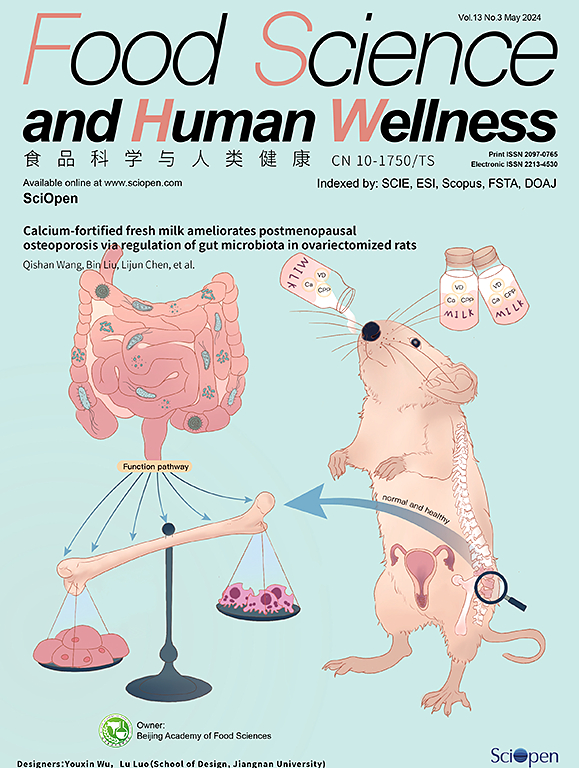肠道微生物群组成对小鼠个体间抗胆固醇治疗效果变化的影响
IF 7.4
1区 农林科学
Q1 FOOD SCIENCE & TECHNOLOGY
引用次数: 0
摘要
本研究探讨了抗胆固醇(AC)治疗对小鼠个体效果的差异是否与肠道微生物组的组成有关。研究人员检测了 23 种商业发酵乳制品的胆盐水解酶(BSH)活性,以选择一种发酵乳制品进行 AC 处理。给小鼠喂食不同的饮食 6 周:高脂肪(总热量的 660% 来自脂肪;D1)、高膳食纤维(20% 纤维素;D2)和低脂肪(总热量的 17.2% 来自脂肪;D3)饮食,以改变它们的肠道微生物组。随后,将粪便微生物组移植(FMT)到含有 2% 胆固醇的高胆固醇饮食处理的小鼠体内,再进行 AC 或非 AC(无菌自来水,STW)处理。正常饮食(NC)和高胆固醇饮食(PC)对照组均用于 AC 和 STW 处理。所有实验组都进行了血清和肝脏胆固醇、胆固醇代谢相关(CMR)基因表达和肠道微生物组分析。D3-FMT小鼠在接受AC治疗后,胆固醇比率显著提高,肝脏胆固醇水平显著降低。此外,在该组中还观察到 Cyp7a1 基因表达的上调。此外,肠道微生物组分析表明,与其他组相比,D3-FMT + AC 组中产生 BSH 的 Eubacterium、Bifidobacterium 和 Parabacteroides 的丰度更高,这可能有助于胆汁酸合成的增加。本文章由计算机程序翻译,如有差异,请以英文原文为准。
Influence of gut microbiome composition on effect variations of anti-cholesterol treatment among individual mice
This study investigated if the variation in the effect of anti-cholesterol (AC) treatment on individual mice are related to gut microbiome composition. The bile salt hydrolase (BSH) activity of 23 commercial fermented milk products was examined to select a fermented milk product for AC treatment. Mice were fed to different diets for 6 weeks: high-fat (660 % of total calories from fat; D1), high-dietary fibre (20 % cellulose; D2), and low-fat (17.2 % of total calories from fat; D3) diets to change their gut microbiomes. Subsequently, faecal microbiome was transplanted (FMT) into mice treated with high cholesterol diet contained 2 % cholesterol, followed by AC or non-AC (sterile tap water, STW) treatments. Control groups with normal (NC) and high-cholesterol diets (PC) were prepared for both AC and STW treatment. All experimental groups were subjected to serum and liver cholesterol, cholesterol metabolism-related (CMR) gene expression, and intestinal microbiome analyses. D3-FMT mice showed the most significant enhancements in cholesterol ratio and decreased hepatic cholesterol levels with AC treatment. Moreover, upregulation of the Cyp7a1 gene expression was observed in this group. Furthermore, the intestinal microbiome analysis indicated higher abundances of BSH-producing Eubacterium, Bifidobacterium, and Parabacteroides in the D3-FMT + AC group compare to others, potentially contributing to increased bile acid synthesis.
求助全文
通过发布文献求助,成功后即可免费获取论文全文。
去求助
来源期刊

Food Science and Human Wellness
Agricultural and Biological Sciences-Food Science
CiteScore
8.30
自引率
5.70%
发文量
80
审稿时长
28 days
期刊介绍:
Food Science and Human Wellness is an international peer-reviewed journal that provides a forum for the dissemination of the latest scientific results in food science, nutriology, immunology and cross-field research. Articles must present information that is novel, has high impact and interest, and is of high scientific quality. By their effort, it has been developed to promote the public awareness on diet, advocate healthy diet, reduce the harm caused by unreasonable dietary habit, and directs healthy food development for food industrial producers.
 求助内容:
求助内容: 应助结果提醒方式:
应助结果提醒方式:


